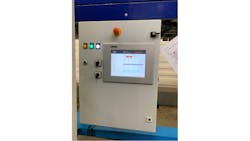Condi Food Develops Hyperspectral Imaging Sorting Solution
Condi Food (Sassenheim, The Netherlands), a developer of in-line hyperspectral inspection systems for the food industry, recently developed a machine vision-based inspection system that uses hyperspectral imaging to inspect cherry tomatoes for optimal taste.
At first the idea of using a vision system to determine the taste of a cherry tomato sounds counterintuitive. After all, taste, in and of itself, is a quality that is not only invisible but subjective—not quantifiable at all. Or is it?
Hyperspectral imaging involves using a hyperspectral camera to capture an image of a given scene’s light, separated into the light’s individual wavelengths (spectral information) to provide a two-dimensional image. Some of these spectral wavelengths are beyond the range of visible RGB light, which means much more data is captured. At the same time, the camera also records the spectral information of each pixel in the image. The result of this process is a hyperspectral image, in which each individual pixel represents a unique light spectrum. And because the spectral signature of each pixel is unique, these signatures can be used to identify and quantify the contents of each scene. So, a hyperspectral imaging system combining digital imaging and spectral response to detect, classify, and analyze objects can provide spatial and spectral information about a given object’s physical and chemical properties.
The most common method of inspecting and sorting produce such as tomatoes relies on color and shape as the main criteria for judging ripeness and sorting and categorizing accordingly. In fact, the company for which Condi Food developed this system already had an automated sorting system in place, which uses two RGB industrial cameras to record color and shape of the tomatoes as they come down two lanes on a conveyor belt to be inspected and subsequently sorted into several different categories.
In this case, this variety of cherry tomato with a deep red color is generally assumed to be ripe, and by extrapolation, generally assumed to be flavorful. However, there is a simple but significant caveat to this. That is, all the most flavorful cherry tomatoes are red, but not all red cherry tomatoes are flavorful. This is because there are more elements than ripeness that define taste.
“Based on the color alone, they couldn't sort out the tomatoes they wanted,” says Condi Food Managing Director Jacques van Munster van Heuven. “A few days after the harvest, they're all red.”
The result was that the grower’s inspectors had difficulty deciding, by color and size alone, the degree of ripeness, and consequently, whether or not the tomatoes would be flavorful. Indeed, some tomatoes simply do not taste as good as they look. For a company trying to sell produce at a premium price based on flavor and ripeness, this can be a significant issue, van Munster van Heuven notes.
See Related Content: Michigan State University's Vision System Sorts and Grades Sweet Potatoes
Components of the Hyperspectral Imaging System
Condi Food does not design or manufacture sorting systems, but rather develops and integrates hyperspectral imaging solutions into existing systems, van Munster van Heuven explains. In this case, the Condi Food system utilizes a Specim (Oulu, Finland) FX17 near infrared hyperspectral camera, which is housed inside an enclosure that straddles a two-lane conveyor belt. The camera, which can scan 60 tomatoes per second, is wired via Ethernet cables to an industrial PC located next to the conveyor line. The computer is equipped with machine vision software developed and written by Condi
The Condi Food team also custom built two halogen lighting fixtures, one for each conveyor lane, to illuminate the scanning area for the hyperspectral camera, van Munster van Heuven says.
“These are moving fast and taking many images quickly, so you need a lot of light,” he says. “We built our own lighting lines because there was nothing available on the market that we could use.”
See Related Content: Hyperspectral Imaging Gauges Salmon Maturation
How the Hyperspectral Imaging System Works
The Condi Food team integrated the camera system into the grower’s existing sorting system and had the sorting system’s manufacturer adjust that system’s software so that it can sort using three criteria, size, color, and taste.
Condi Food’s part of the system is only providing the hyperspectral information and quality grades to help better determine taste.
Tomatoes harvested from the field are loaded onto the conveyor belt in the sorting facility. The belt transports the tomatoes under the spectral imaging camera mounted over the conveyor belt. This camera captures the spectral image data and transmits it to the computer, which is loaded with Condi’s machine vision software. The software, based on statistical models rather than AI, is then used to process and analyze the images and generate a report, which is transmitted to the grower’s server, also located on-site.
Taste criteria, of which ripeness is only one step, are established by a small group of the grower’s experts—the taste panel. Spectral images that “see” chemical make-up and other such characteristics inside the skin of the tomato are captured from the examples that the taste panel determines as optimal. This data is then used to build the inspection models.
Based in the spectral signatures compared to the optimum examples, the system assigns numbers denoting quality level ranges to each image. The taste model is a more holistic model, van Munster van Heuvel says. For other applications, the degree of ripeness, Brix as well as other criteria such as pH and TZ levels, are determined via these spectral signatures.
“We don’t share the image, we only share the outcome of the model,” van Munster van Heuvel says.
Since the grower has a number of different quality levels by which their tomatoes are being sorted, the grower can use those numbers generated by the hyperspectral system to properly and accurately sort the tomatoes to their appropriate destinations.
Challenges for the Hyperspectral Inspection System
One challenge was in the development of models, van Munster van Heuven says. Tomatoes are especially complex, with many different elements contributing to spectral signature. Also, from the time they are picked to the time they are packed, tomatoes, like any fruit or vegetable, are changing. Hence, the holistic, wider spectrum approach to criteria such as taste, he says.
The system in and of itself uses the same platform, but it is not turnkey; it must be customized to each project. For example, inspecting avocados would require different parameters from inspecting tomatoes.
About the Author
Jim Tatum
Senior Editor
VSD Senior Editor Jim Tatum has more than 25 years experience in print and digital journalism, covering business/industry/economic development issues, regional and local government/regulatory issues, and more. In 2019, he transitioned from newspapers to business media full time, joining VSD in 2023.



